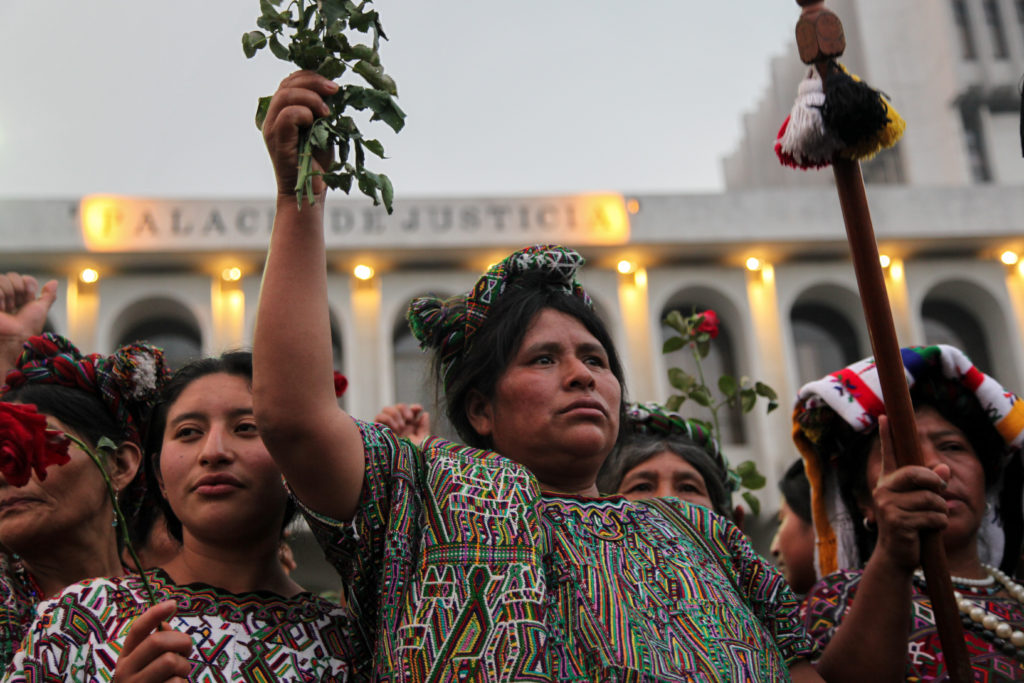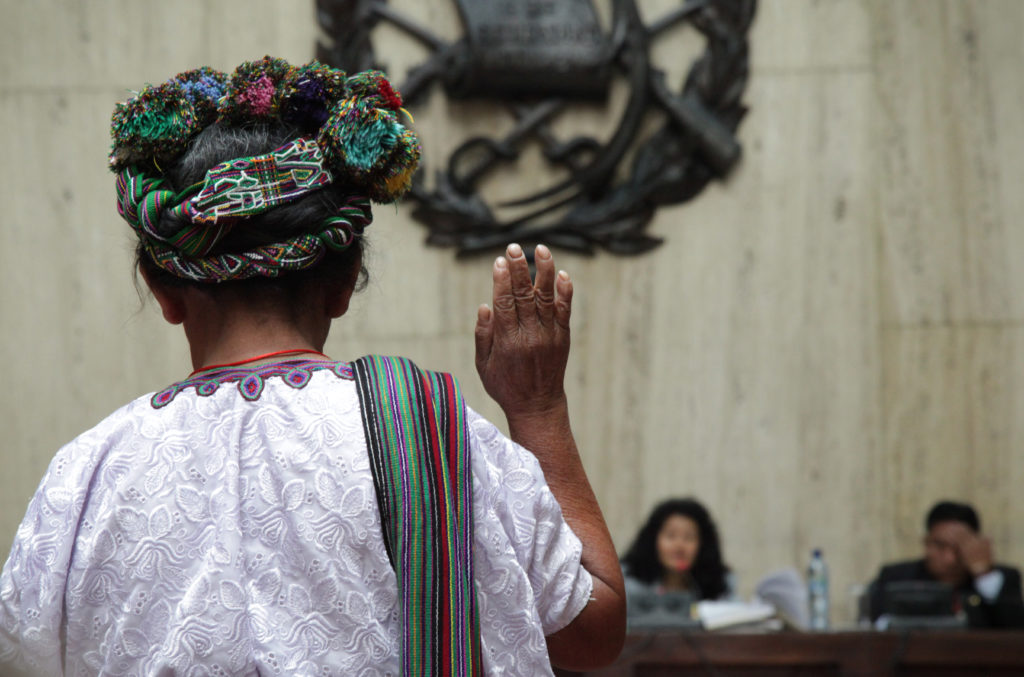
Two indigenous leaders were killed in Guatemala in the final two days of a United Nation expert’s visit to the country, soberly underlining her call for the state to overhaul its relationship with its indigenous majority.
UN special rapporteur for indigenous rights, Victoria Tauli-Corpuz, noted indigenous groups suffer structural discrimination and exclusion, including a lack of consultation for projects on their land, forced displacement, unfulfilled reparations for a bloody genocidal past, and soaring poverty.
Tauli-Corpuz said the racism amounts to a “situation of de facto racial segregation” and called on Guatemala to “break the cycle of discrimination” against indigenous people. In a phone interview with Toward Freedom from New York, she clarified that this is a “persistent” cycle that “never has ended,” stretching from colonization through to the present.
Days after the conclusion of her mission, a third indigenous leader was killed in the span of just five days. The three victims, Luis Marroquin, Jose Can Xol, and Mateo Chamán Paau, worked in movements that have decried the displacement of indigenous farmers to make way for resource extraction projects on their lands.
Tauli-Corpuz highlighted land conflicts and increased forced eviction of indigenous communities as leading problems. She said land grabs have “multiplied several times” in Guatemala as extractive industries, mega-infrastructure developments, and agribusiness plantations exploit traditional indigenous territories.
The expansion of these sectors to new scales only tightens the squeeze in one of the most unequal land distributions in the region. In Guatemala, less than 2 percent of farms consume over half the arable land, according to the UN Food and Agriculture Organization.
The rapporteur’s observations resonated with Sister Maudilia López Cardona, who works with the Catholic parish in her western Guatemalan community, San Miguel Ixtahuacán. She has spent the better part of the past two decades resisting one of the world’s largest gold mines, the Marlin mine. Owned by Canadian mining giant Goldcorp, the Marlin mine shut down one year ago, but San Miguel continues to suffer the consequences, including heavy metals in the water and residents’ blood.
“In the end, the [mining] company is a new form of colonization and exclusion,” López told Toward Freedom during a speaking tour in Toronto. “Not taking into account the life of the people — it’s discrimination because they see the [indigenous] people as second-rate quality.”
López said that although UN reports are beneficial in bringing attention to systemic problems, the challenge is that they are “only recommendations to the country, not a mandate.”
The Marlin mine’s installation and operation in San Miguel was plagued by irregularities. The local Maya Mam people say Goldcorp and its Guatemalan subsidiary, Montana Exploradora, never consulted them, despite their international right to free, prior and informed consent. The previous UN special rapporteur for indigenous rights, James Anaya, found in 2011 that this was indeed the case.
Now, Tauli-Corpuz reported that the trend has only continued. Despite the fact that Guatemala has ratified the Indigenous and Tribal Peoples Convention, known as ILO 169, which enshrines the right to consultation for development on their territories, there is “hardly any” free, prior and informed consent in Guatemala, she told Toward Freedom.
“Aside from the fact that consultation has not been done [and] consent has not been obtained, the people who are leading the struggle to get the government to recognize their basic rights are also criminalized,” Tauli-Corpuz said. The lack of community consultation is also fueling forced evictions, reinforcing historical land inequalities, she added.
Paulo Estrada, a human rights defender and child of a forced disappearance victim, tied the criminalization of land defenders today to the more explicit violence of the past. “Now there aren’t forced disappearances, there are political prisoners,” he said. “State violence never ended, it only changed.”
Land conflicts are also a central thread connecting past and present. Guatemala’s deep land ownership inequality was a root cause behind the brutal 36-year civil war and a key part of the peace accords that ended the conflict.

In 1954, a CIA-orchestrated coup ousted Guatemalan President Jacobo Árbenz, who had instigated land reform to benefit the country’s mostly indigenous peasants. At the time, foreign companies, such as US banana giant United Fruit Company, dominated prime agricultural lands. The civil war broke out six years later. It wasn’t long before the US-backed military regimes targeted anyone suspected of sympathizing with the rebel forces, which had a bloody toll in indigenous communities.
At least 200,000 people were killed in the conflict, according to the UN-mandated truth commission. One million more were internally displaced. State and aligned paramilitary forces were responsible for 93 percent of abuses, and the vast majority of their victims were Mayan.
Few high-ranking military officers have been prosecuted for their roles in historical crimes against humanity, including a genocide campaign in the 1980s under former dictator General Efraín Ríos Montt. A historic 2013 guilty verdict against Ríos Montt for genocide and crimes against humanity was swiftly overturned. He died in April amid a retrial.
Tauli-Corpuz stressed that the failure to redress these historical abuses with reparations represents lasting institutional racism and discrimination. The implementation of just 19 percent of the Agreement on Identity and Rights of Indigenous Peoples accompanying the 1996 Peace Accords “is a manifestation of how the state regards indigenous peoples in Guatemala,” she said.
Estrada said the rapporteur’s visit helps shed light on these shortcomings. “It’s a tool to be able to make [the problem] visible and pressure the state to fulfill agreements,” he said.
He added that the past two administrations in particular have maintained a de facto “policy of forgetting and impunity.” Meanwhile, top ranking military officials keep a “pact of silence” about the past. This complicates uncovering historical truth, which, together with access to justice and reparations, is part of building transitional justice to ensure Guatemala never again suffers such atrocities, he said.
Tauli-Corpuz applauded historic steps toward justice, such as the 2016 guilty verdict against two former military men for systematic rape and enslavement of 11 women in the precedent-setting Sepur Zarco case. But she also urged for implementation of the 18 court-issued reparation measures in the case, including reopening land restitution cases and establishing a health center in Sepur Zarco.
In general, she added: “collective reparations as well as individual reparations still remain as a demand for indigenous peoples.”
Ruben Dominguez, a lawyer with the Human Rights Law Firm in Guatemala, said that reparations, including non-monetary reparations, serve to dignify victims and their families and “avoid repetition.”
“These non-economic reparations aim to keep a memory of what happened,” he said. Such “comprehensive reparations” can include monuments, public apologies, land restitution, and other measures that solidify a sense of justice. But he added that a lack of political will has frustrated longstanding efforts to seek criminal prosecutions for civil war crimes against humanity, as well as fulfillment of human rights obligations and reparations.
Dominguez suggested that land restitution, in particular, would provide the legal guarantees to empower indigenous communities to pursue local development projects. “They live in uncertainty, because at any moment they could lose their lands,” he said of the status quo.
According to Tauli-Corpuz, reparations through land reform and granting of communal titles for traditional lands is a key part of enabling indigenous’ communities sustainable well-being.
“There are existing alternatives,” she said. She pointed to long-standing indigenous traditions of sustainable forest management, traditional agriculture, and other livelihoods, and highlighted how many communities with strong traditional indigenous authorities have flourished. “It is a matter of providing the possibilities for them to continue doing this and strengthening … their inclusion when development priorities of the state are being decided and agreed upon.”
For Sister López from San Miguel Ixtahuacán, popular education is key to validating these alternatives and empowering communities to defend their rights, lands, and resources.
“The system has worked to erase the historical memory of our people and teach us not to think,” she said. “These thoughts, these ideas, these preconceptions have soaked into our people’s bones … We have to work to return our hearts to their place.”
